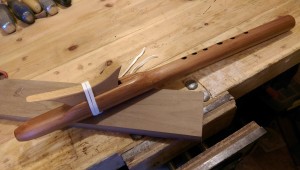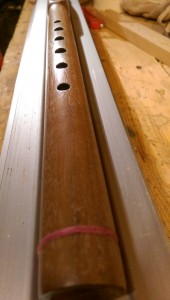8 – Initial Finishing
So – having done the basic shaping, what we now have is a flute-shaped tube with a gaping hole in the front surface; it is rough, unpolished and has no playing holes. The next parts could be done in either order – it doesn’t really matter… but I prefer to do the initial sanding now, then the playing holes and initial tuning, then the fine sanding, and finally the finest tuning.
Sanding
Sand everywhere except the nest, initially; this area is critical and needs extra care. Start with a 120 grit or near to it; sand the entire surface, and use a tack-cloth to remove  dust – you should start to see nicks, dents and tooling marks – which you should remove as far as you can with this rough paper. Move up to 240 grit only when you can’t see any more blemishes; run your hand over the surface; you’ll be able to feel rough patches before you can see them. Take a little longer with the 240; again everywhere except the nest. Once you’re done with the 240, use your vernier calipers’ depth gauge to find the flue’s depth near the south end; if it’s 1mm or more, you need to use the 240 grit to steadily work it down to 0.9mm deep. You should do this with your sandpaper wrapped around a cork or solid rubber sanding block with a flat base, or (preferably) with your sandpaper on a machined flat surface such as a bandsaw table, turn the flute upside down and run the flute back and forth over the sandpaper. Keep checking the flue depth. Then use the 400 grit in the same way, until it’s down to 0.8 ish – not less, perhaps a tiny bit more; 0.82. Then you can pick up the flute and sand with 400 grit across the whole body.
dust – you should start to see nicks, dents and tooling marks – which you should remove as far as you can with this rough paper. Move up to 240 grit only when you can’t see any more blemishes; run your hand over the surface; you’ll be able to feel rough patches before you can see them. Take a little longer with the 240; again everywhere except the nest. Once you’re done with the 240, use your vernier calipers’ depth gauge to find the flue’s depth near the south end; if it’s 1mm or more, you need to use the 240 grit to steadily work it down to 0.9mm deep. You should do this with your sandpaper wrapped around a cork or solid rubber sanding block with a flat base, or (preferably) with your sandpaper on a machined flat surface such as a bandsaw table, turn the flute upside down and run the flute back and forth over the sandpaper. Keep checking the flue depth. Then use the 400 grit in the same way, until it’s down to 0.8 ish – not less, perhaps a tiny bit more; 0.82. Then you can pick up the flute and sand with 400 grit across the whole body.
This done, the surface of the flute should be silky smooth to the touch, but not shiny in appearance. If you wish to do the initial tuning now, this is the time. Skip to the next article and come back here later.
Now you start with the 600 grit paper; on the nest (because 600 is so fine a grade) you don’t need to be so terrified of causing a problem; but sand lightly  and evenly, and check depth often to make sure you don’t go below the magic 0.8mm. To be “even”, use long, steady strokes which cover the entire nest area, back and forth in a rhythm. Then do the entire flute body, take care to know where you’ve been and try to cover it all with the same amount of sanding. With this done, you should start to find a slight sheen to the appearance, and the surface on harder woods will seem almost impossibly smooth.
and evenly, and check depth often to make sure you don’t go below the magic 0.8mm. To be “even”, use long, steady strokes which cover the entire nest area, back and forth in a rhythm. Then do the entire flute body, take care to know where you’ve been and try to cover it all with the same amount of sanding. With this done, you should start to find a slight sheen to the appearance, and the surface on harder woods will seem almost impossibly smooth.
Now we get silly… we use “Extra Fine” wire wool: 0000 grade. Go over the whole flute for a good long time, rubbing vigourously and changing wool as often as you feel you need to. After this, your flute’s surface will actually be shiny; it will feel wonderful to the touch. You can on the harder woods go even further, using “MicroMesh” sanding cloths – I tend to go up to 3200 or 3600 grit. (On very soft woods I usually wouldn’t bother going past the wire wool, and a deep and coarse grain might even make me think about stopping at 600 grit).